Our School—A Happy Place NCERT Solutions | Our Wondrous World Class 5 - New NCERT PDF Download
| Table of contents |

|
| Page No. 56 |

|
| Page No. 57 |

|
| Page No. 59 |

|
| Page No. 60 |

|
| Page No. 61 |

|
| Page No. 62 |

|
| Page No. 63 |

|
| Page No. 64 |

|
| Page No. 68-69 |

|
| Page No. 70 |

|
| Page No. 71-72 |

|
Page No. 56
Activity 1
Walk around your school and create its map. Include the main building, playground, garden, water tanks and other key features. Do not forget the school gate and the pathways that connect the buildings.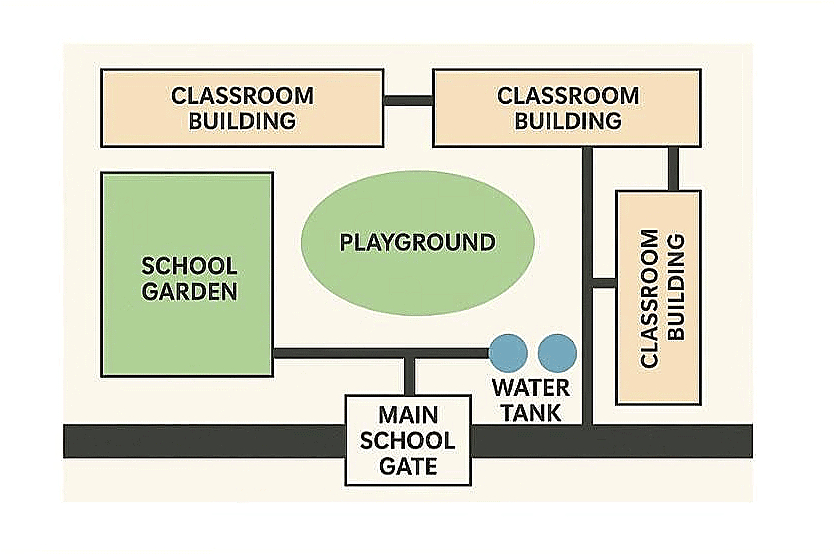
Page No. 57
Write
Q1. What do I really like about my school?
Ans: I like that my school is clean, has friendly teachers and kind students. I enjoy playing in the playground and learning new things every day.
Q2. How can I make my school greener?
Ans: I can plant more trees and flowers, use water carefully, not waste electricity, keep the classroom clean, and encourage others to use dustbins. I can also care for the plants in the school garden.
Q3. In case there is any difficulty at school, to whom do I talk or inform?
Ans: I can tell my class teacher, principal, or any school staff member I trust about my problem or difficulty.
Page No. 59
Write
Q. Can you name the colour of the bin used for the following?
Ans: Dry waste: Blue bin
Wet waste: Green bin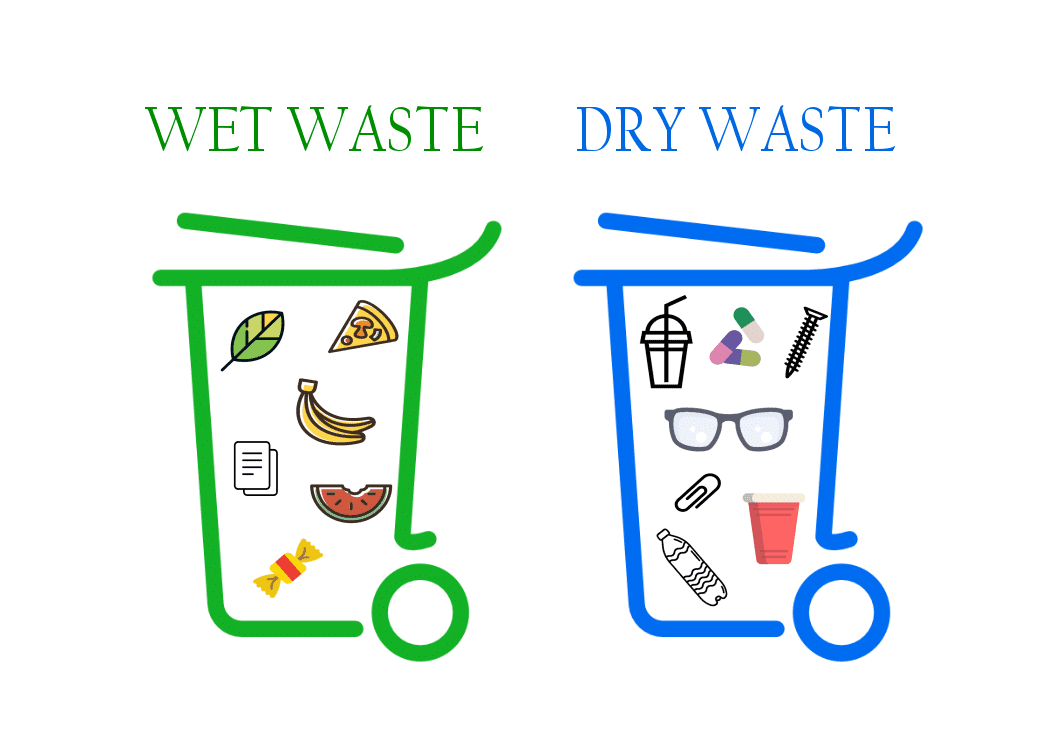
Page No. 60
Write
Q1. What things does your school give to recyclers?
Ans: Old newspapers, notebooks, paper, plastic bottles, metal cans, and sometimes old equipment or broken furniture.
Q2. Ask your parents and find out if there are any items that they have set aside to give to the recyclers. What are they?
Ans: My parents keep old newspapers, glass bottles, cardboard boxes, plastic containers, and metal cans to give to the recycler/kabadiwala.
Find out
Q. With the help of your teacher, ask a recycler to visit your class and share what they do at work. It will be interesting to find out where these items go and how they can be reused or recycled.
Ans: If a recycler visits, ask them questions like:
- What kind of materials do you collect?
- Where do you take these items after collecting them?
- How are these things recycled or reused?
You will learn that waste like paper and metal can go to factories to be made into new products.
As a recycler, here’s how I handle materials and recycling:
Materials collected: I collect various waste materials such as paper, plastic, glass, metal, and sometimes electronic waste. These are common items people throw away, but can be recycled.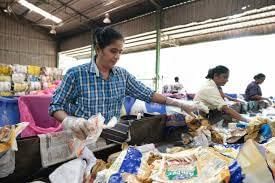 Where items go: After collection, these materials are taken to recycling centres or facilities. At these centres, the items are sorted, cleaned, and prepared for processing.
Where items go: After collection, these materials are taken to recycling centres or facilities. At these centres, the items are sorted, cleaned, and prepared for processing.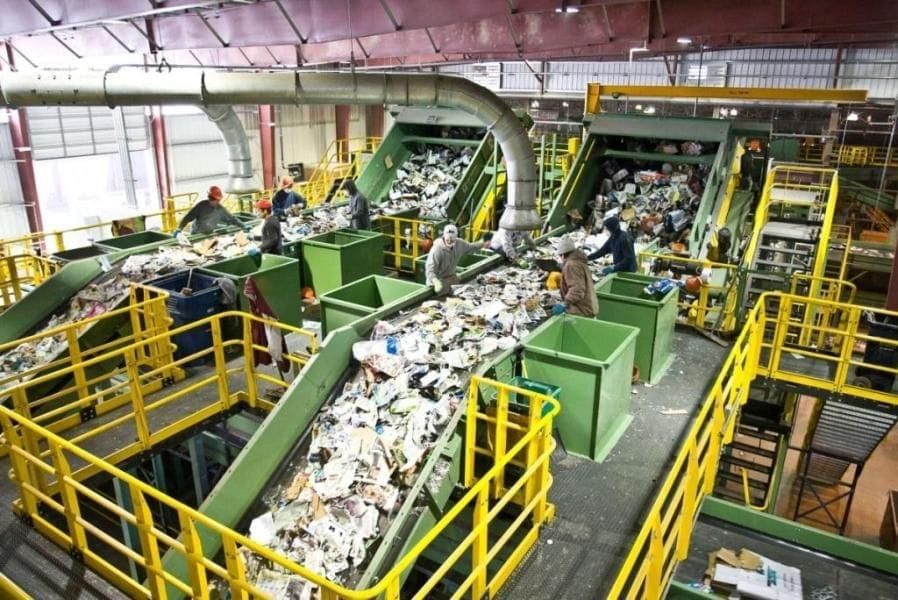 How recycling/reuse happens:
How recycling/reuse happens:
- Paper is pulped and made into new paper products like notebooks and packaging.
- Plastic is melted and reshaped to create new containers, bottles, or packaging materials.
- Glass is crushed and melted to form new glass bottles or jars.
- Metal is melted and recast into new cans, tools, or parts.
- Electronic waste is carefully dismantled to recover valuable parts and materials for reuse or proper disposal.
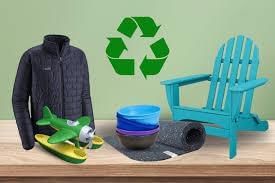
Page No. 61
Activity 2
Segregation Game
Make small paper chits (30-40) with the names or drawings of the different items shown below. Add more items to the list based on what you see around your school or home.
Take three empty boxes, and label them-green for wet waste, blue for dry waste, and the third can be labelled as ‘Ttems for recycler’. One by one, pick a chit and put it in the box that is correct. After all the chits have been put in the boxes, take one box at a time and discuss whether it has been put correctly.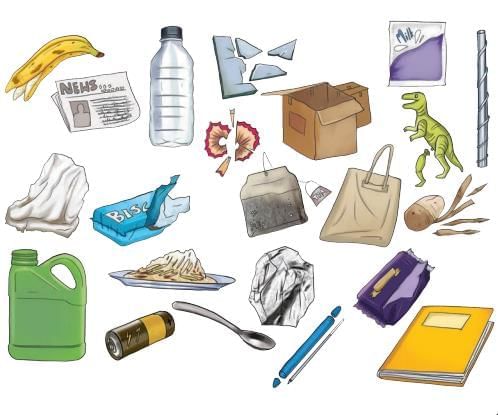
Ans:
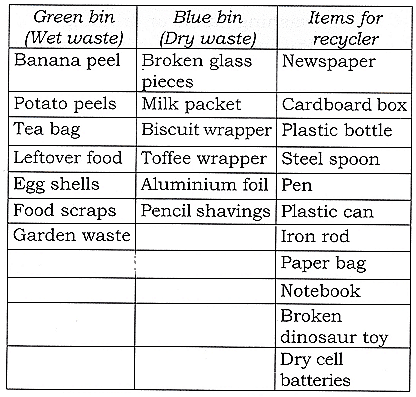
Intext (Page 62)
Q1. How is wet waste managed?
1. In your school
2. In your home
Ans:
1. In our school, wet waste like fruit peels and leftover food is collected in green bins. This waste is sent for composting or picked up by garbage collectors for proper disposal.
2. In my home, we collect wet waste like vegetable peels, fruit peels, leftover food, and used tea leaves separately in a covered container. We do not mix it with dry waste. This wet waste is either used for composting in our garden or given to the garbage collector for proper disposal.
Page No. 62
Discuss
Q1. What happens if we do not separate our waste?
Ans: If we do not separate waste, it all gets mixed up and is harder to recycle, making the environment dirty. Harmful things can pollute the soil and water, and sanitation workers may face health risks.
Q2. What can we do to make the work of sanitation workers easier and safer?
Ans: We must always put waste in the correct bin, avoid throwing sharp or harmful objects with regular waste, and respect and thank the workers for their work. Invite them to share their experience, and learn how to help make their jobs safer.
Activity 3
Take two tiles or stones, paint one black and the other white. Keep them under the Sun. After a while, touch each of them and feel the difference in their temperature. Which one felt cooler?
Ans: Paint one stone black and another white. Keep both in the Sun. After some time, touch them. The white stone will feel cooler because it reflects sunlight. The black stone absorbs more heat and feels hotter.
Page No. 63
Write
Q. If you have to paint the roof of your school or home white, what would happen?
Ans: The rooms inside would stay cooler in summer because white reflects sunlight and keeps heat out.
Discuss
Q. If your area is getting warmer, what actions can be taken to keep it cool?
Ans: Plant more trees and bushes, paint roofs and walls white, use curtains on windows, save water, and encourage everyone to use less electricity by switching off fans and lights when not needed.
Page No. 64
Activity 4
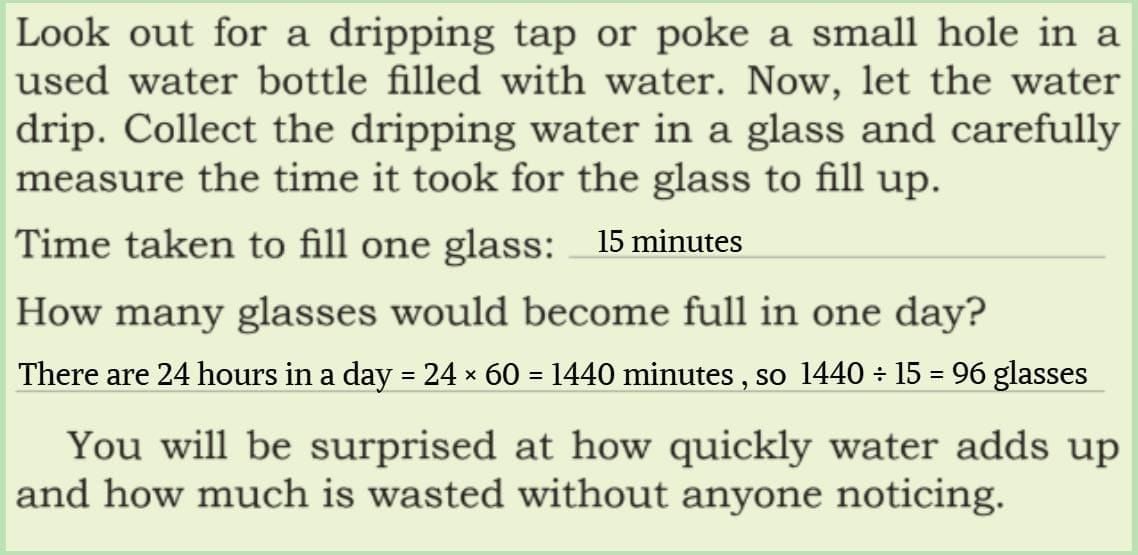
Discuss
Q1. What are some easy things we can do in our school to prevent the wastage of water?
Ans: Fix leaking taps, close taps tightly after use, use buckets instead of hoses for cleaning, and tell a teacher if you see water being wasted.
Q2. How can you collect and use rainwater at home or in school?
Ans: Place containers under the roof to collect rainwater. This water can be used for gardening or washing. Schools can install rainwater harvesting systems to collect and store rainwater for various uses.
Page No. 65
Write
Q1. Name the trees on your campus or near your school.
Ans: Example: Neem, Peepal, Banyan, Mango, Ashoka, Gulmohar, etc.
Q2. Which birds and insects have you seen near the plants or trees on your school campus?
Ans: Sparrows, crows, maina, pigeons, butterflies, honeybees, ladybugs, etc.
Page No. 66
Activity 5
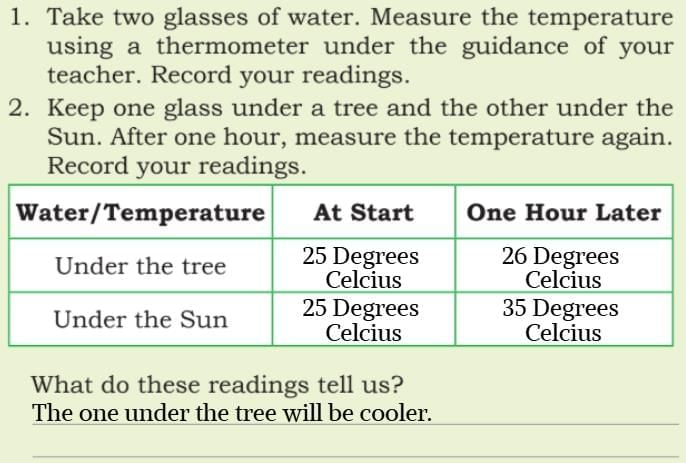

Ans: Trees and Plants That Attract Birds and Butterflies
With the guidance of our teacher, we identified several trees and plants that are known to attract birds and butterflies.
Plants that attract butterflies
Some flowering plants that attract butterflies include Milkweed, Lantana, Marigold, Zinnia, Butterfly Bush (Buddleia), and Sunflower. These plants are rich in nectar and are bright in colour, which helps in drawing butterflies to the garden.
Trees and shrubs that attract birds
Birds are attracted to trees that provide food, shelter, and nesting areas. Neem, Peepal, Guava, Indian Coral Tree (Erythrina), Jamun, and Amaltas are some of the trees that attract various species of birds.
Steps to Create a Butterfly Garden in the School
- We plan to choose a sunny, open area in the school where we will plant a mix of nectar-rich flowers and native trees.
- Some shaded spaces will be included by planting trees along the edges.
- Small water trays will be placed for butterflies to drink water.
- Fruit or grain trays may also be placed occasionally to attract birds.
- We will ensure the garden remains pesticide-free to keep it safe for insects and birds.
- Plant name tags will be added to help students identify and learn about them.
Page No. 67
Write
Q1. Find out and write at least three traffic rules.
- Stop at red traffic lights.
- Always walk on the footpath or the left side of the road.
- Do not run or play on the road.
Q2. Think and write about what you saw at the school gate.
- I saw many students with their parents, some traffic, and a guard helping children cross safely.
- Some cars stopped, but a few did not pay attention to slow down near the school gate.
Now, work in teams to design a signboard for the school gate.
Students can take reference from the following: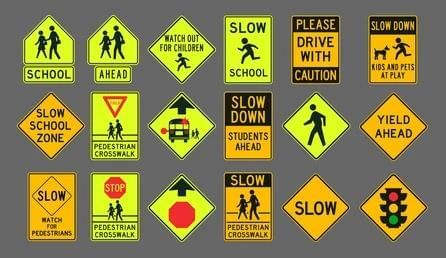
Page No. 68-69
Discuss
Q. Besides making signboards, what else can we do to improve traffic near the school?
Ans: Place speed breakers, have a guard or teacher on duty, educate parents to park properly, have clear road markings, and inform local authorities if needed.
Write
Q1. Where is the fire extinguisher kept in your school?
Ans: Near the main entrance or on each floor, sometimes near the staircase or laboratory.
Q2. In case of a fire, where is the assembly point in your school?
Ans: Usually in the playground or open field, marked as "Assembly Point." Ask your teacher for your school’s exact spot.
Q3. What should you do if there is a fire or if you smell smoke?
Ans: Do not panic. Quickly walk out by the nearest exit, crawl under the smoke, do not hide, and gather at the assembly point. Inform adults about missing friends or teachers.
Page No. 70
Activity 6
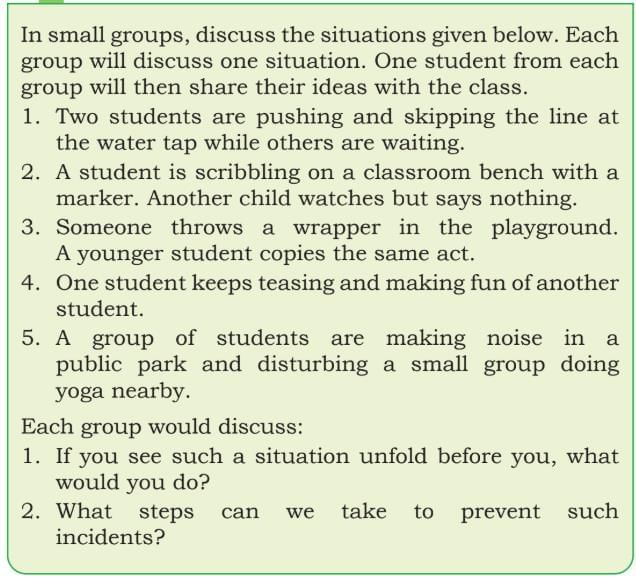
Ans: In groups, act out or discuss:
1. Two students are skipping the line at the water tap.
Solution: Politely remind them to wait, and arrange for everyone to take turns.
2. A student scribbles on a bench.
Solution: Remind them to keep the class clean and offer to help clean it up.
3. Someone throws a wrapper.
Solution: Pick it up and use the dustbin. Teach younger children by example.
4. One student is teasing another.
Solution: Stand up for the child being teased and tell a teacher.
5. A group making noise in the park.
Solution: Request them to keep quiet so others can do yoga or relax.
Page No. 71-72
Let us reflect
1. Out of all the classrooms in your school, which one do you think is the nicest and why?
Ans: I think the science classroom is the nicest in my school.
- It has large windows that allow a lot of sunlight to come in, making the room feel bright and cheerful.
- The walls are decorated with beautiful charts and models about nature, animals, and plants, which make learning more interesting.
- There are plants in the classroom, and sometimes students bring in flowers to add to the decoration.
- The teacher keeps the classroom clean, and all the cupboards are neatly organised with science kits.
- The atmosphere in the class feels calm, and the teacher encourages us to ask questions and try out experiments.
- This environment makes me feel happy and curious to learn new things every day.
2. Create a happiness tree: On a wall or chart paper, draw a large tree with many branches. Each student adds a leaf with one small action written on it that makes the school a happier place (like greeting someone, turning off lights, sharing space, etc.).
Ans: Steps to create a happiness tree:
- I would start by drawing a large tree with many branches on the wall of our classroom.
- Each student will cut out a green paper leaf and write one kind action on it.
- For instance, my leaf might say, “I always help a friend find their lost things.”
- Other students could write things like:
“I greet everyone with a smile,”
“I remind others to switch off lights.”
“I share my snacks during break.” - We will attach all the leaves to the tree until it looks full and beautiful.
- Every time someone does something nice, they can add a new leaf to the tree.
- This happiness tree will remind us that even small actions, like giving a compliment, keeping our space clean, or including everyone in games, make our school a happy place.
3. Sharing your feelings is exciting. Write a letter to your teacher on ‘My School—My Happy Place’.
Ans: My letter:
Dear Teacher,
I am very happy to write to you about why my school is my happy place. My school is not just a building; it is a place where I feel safe and loved. I enjoy meeting my friends every day and learning something new in every class. My school has a big playground where we play different games, and there are many green trees and bright flowers around the campus. Teachers here are always kind and help me when I do not understand something.
I like how our school works hard to keep everything clean and green, and how everyone cares about saving water and electricity. Our classroom projects and activities help me feel like I can make a difference. Coming to school gives me joy and confidence, and I look forward to each day here. Thank you for making my school a place where I feel happy and proud.
Your student,
[Your Name]
4. Which actions from the chapter would you extend to your home, neighbourhood, and community to make them happy places for all? Describe any one of these actions in detail.
Ans: From the chapter, I would like to extend the action of "waste management" to my home and neighbourhood.
- At home, I can make sure to sort my waste into dry and wet categories, just like we do at school.
- I can use two dustbins: one for food and kitchen waste, and another for paper, plastic, and other dry items.
- I would also encourage my family to collect newspapers and bottles separately.
- This way, we can give them to recyclers for proper recycling.
- In my neighbourhood, I can speak with my friends and neighbours about the importance of not littering and keeping our surroundings clean.
- If we notice any trash, we should pick it up and place it in the right bins.
- Occasionally, I can organise small clean-up drives with my friends in the park or around our homes.
- Taking such actions will help make our community clean, green, and healthy.
- Additionally, our efforts can motivate others to join in and help as well.
5. Imagine a day in school from someone else’s perspective. Choose one:
- A student using a wheelchair.
- A student who speaks a different mother tongue.
- A sanitation worker at school.
Write a diary entry from their point of view. What did they feel? What was easy or hard? What made them smile or worry?
Ans: Diary Entry – From a sanitation worker’s perspective:
Dear Diary,
Today was just like any other busy day at school. I arrived early to clean the classrooms and sweep the corridors before the students came. Some areas were messy, especially the playground after lunch, but most children in this school are neat and say “thank you” when I clean their classroom. That makes me smile and feel respected.
The hardest part is when some students throw wrappers on the ground even when dustbins are close by, or when people forget to thank me for my hard work. Carrying heavy trash bags and cleaning the washrooms is also tiring. But I enjoy seeing the school look bright and children playing safely.
The best part of my day was when a group of children greeted me, and one girl helped me carry a waste bag outside. I felt proud when the principal praised my hard work in front of everyone.
I just wish everyone remembered that keeping the school clean is everyone’s job—not just mine.
6. If you were the principal for a day, what three changes would you make to make your school happier, safer, and greener?
Ans: If I were the principal for a day:
- I would plant more trees and create a “Butterfly Garden” on campus with help from students and teachers. This would make school greener and give everyone a peaceful place to relax.
- I would organise weekly “Happiness Hours,” where students could sing, play, share stories, or just talk about their feelings. This would help everyone feel included and happy.
- I would put more dustbins all around the campus and start a “Switch Off” campaign for students to check lights and fans before leaving any room, saving electricity and keeping our school safe from fire risks.
These changes would bring students, teachers, and staff together and help everyone care more for the school.
7. In groups of 4–5, act out these scenes:
- A student showing kindness in a difficult situation.
- A team is solving a school water wastage problem.
- A student helping a shy classmate feel included.
After each role-play, ask: What did you see? What inspired you? Could this happen in real life?
Ans: After acting out all three scenes, I feel inspired by the kindness and teamwork shown.
- For example, in the first scene, a student stood up for another who was being bullied and invited them to join a group project.
- In the second, a team realised a tap was leaking in school.
- Instead of ignoring it, they told a teacher, and together they fixed the problem, saving water.
- In the last scene, a new, shy classmate was included in a game, which made them smile and feel welcome.
- These stories helped me understand that small, caring actions can create a big impact.
- Each role-play felt real to me because I have witnessed or gone through similar experiences.
- Yes, acts of kindness and working together can—and should—occur in real life.
- I feel motivated to be that helpful person whenever I have the opportunity.
8. Write a one-minute speech for your morning assembly on ‘My Dream School.’ Mention what makes it special, who helps keep it that way, and what every student can do.
Ans: Good morning everyone,
Today I want to share my thoughts about “My Dream School.”
My dream school is a place where every child feels safe, joyful, and respected. It has clean classrooms, green gardens, and bright, welcoming teachers and staff. In my dream school, we all take care of our playground and plant trees every year. We save water and electricity, and we never litter our campus.
What makes my dream school special is that everyone helps one another. Teachers encourage us, friends support each other, and sanitation workers are always thanked for their hard work. Students are honest, helpful, and always greet others with a smile. Each of us, whether big or small, does our part to follow rules, care for plants, and keep the school clean.
Together, we make our school the happiest place to learn and grow.
Thank you!
9. Take a quick survey: Ask five students and one teacher:
(a) What is the one thing that makes them feel happy in school?
(b) What is one thing that could be improved?
(c) What is one kind thing they saw today?
Present your findings to the class. What did you learn from others?
Ans: Survey Results:
(a) One thing that makes them feel happy in school:
- All five students said that playing on the playground and spending time with friends made them happy.
- The teacher mentioned that helping students learn new things was the happiest part of the day.
(b) One thing that could be improved
- Most students felt that there should be more storybooks in the library and more shade trees outside.
- The teacher wished there could be more dustbins placed around the school.
(c) A kind thing noticed today:
- A girl shared her lunch with a new student.
- A boy helped a younger child who had fallen.
- Someone picked up litter without being asked.
- A friend helped another finish their homework.
- A teacher praised a student for being polite.
What I learned:
Everyone values kindness and a clean, welcoming environment. Sometimes, even small improvements—like more trees, dustbins, and books—can make a big difference. Most of all, kindness is noticed and remembered by all, making the school a better place for everyone.
|
16 videos|144 docs|10 tests
|
FAQs on Our School—A Happy Place NCERT Solutions - Our Wondrous World Class 5 - New NCERT
| 1. What is the main theme of the chapter "Green School"? |  |
| 2. How can students be Electricity Savers in their school? |  |
| 3. What are some effective ways to manage water usage in schools as discussed in "Water Watchers"? |  |
| 4. What role do Waste Warriors play in promoting a cleaner environment? |  |
| 5. How can students contribute to being Traffic Trackers in their school? |  |




















